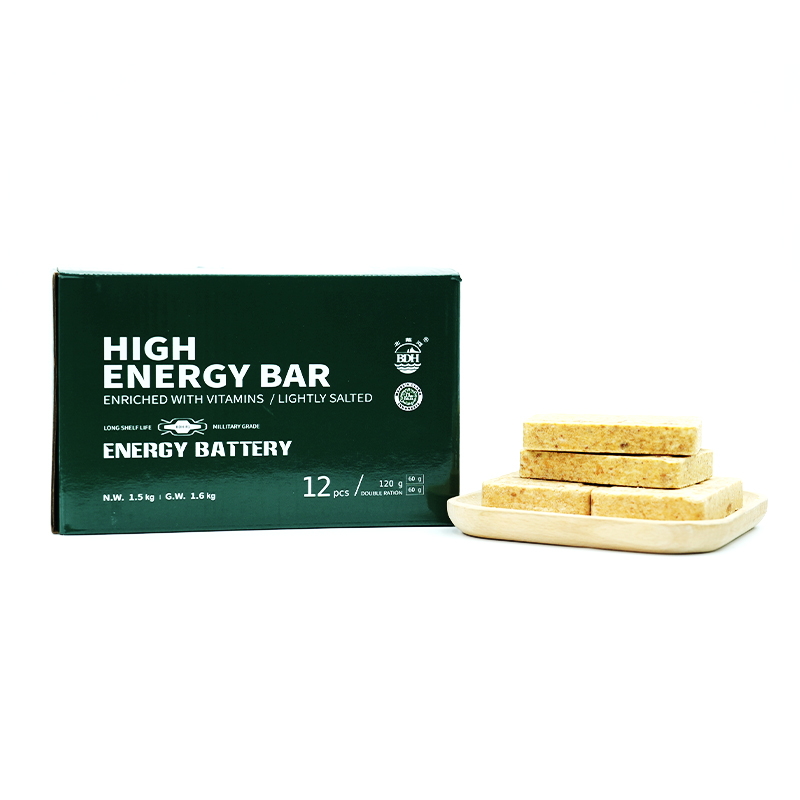Views: 0 Author: Site Editor Publish Time: 2025-09-04 Origin: Site








Are high-energy food bars just a snack or a reliable survival tool? These compact bars are designed for long-term storage and provide concentrated calories. This article explains how emergency food bars work, their benefits, and who needs them. We’ll explore their ingredients, proper usage, and how to choose the best bar for your needs.
Emergency food bars work by providing a dense source of carbohydrates and fats. Your body converts carbohydrates from wheat flour and glucose syrup into glucose for immediate and medium-term energy. Fats from vegetable oil offer a slow-burning, long-lasting fuel source, crucial when meals are infrequent.
Unlike sports bars, the goal is not to boost athletic performance but to provide basic, life-sustaining energy. The combination of simple and complex carbohydrates, along with fats, ensures a steady release of energy over several hours, helping to maintain strength and stave off hunger in demanding situations.

These bars are vacuum-packed and compressed, making them extremely portable. A small bar contains a high number of calories, maximizing the energy you can carry.
Formulated for stability, our bars have a shelf life of up to 20 years when stored properly. This makes them ideal for emergency kits that may be stored for long periods without rotation.
High-energy emergency bars are perfect for various situations:
Natural disaster emergency kits
Military rations
Long-distance hiking and camping
Vehicle survival kits
Quick meal replacement during extended work hours
Our bars are made from simple, stable ingredients:
Wheat Flour & Glucose Syrup: Primary sources of carbohydrates for energy.
Vegetable Oil (Palm): Provides high-density fats for long-lasting calories.
Sugar: Adds quick-energy carbohydrates.
Vitamins and Minerals: Added to help maintain nutritional balance in stressful situations.
This simple formulation avoids perishable items like nuts or dried fruits, ensuring maximum shelf life and stability. There are no artificial colors that could degrade over time.
Consume these bars in situations where normal food is unavailable:
During and after a natural disaster (earthquake, hurricane).
As a ration during long outdoor expeditions.
When working long shifts without a break.
As part of a planned emergency food supply.
As a quick snack.
Always drink an adequate amount of water when consuming the bar. This aids in digestion and helps you feel full.
The main drawback is their dry nature. Consumption without sufficient water can cause discomfort. They are a food source, not a hydration source.
Shelf Life: Look for the longest possible shelf life (e.g., 3, 5, 10, or 20 years).
Caloric Content: Check the calories per bar to ensure it meets your energy needs.
Packaging: Choose bars with robust, waterproof, and airtight packaging.
Certifications: Ensure the product meets relevant food safety and quality standards.
Choose a reputable manufacturer like Qinhuangdao Ocean Food Co., Ltd., which specializes in producing reliable, long-shelf-life food products for global markets.
High-energy emergency food bars are a reliable, efficient source of sustenance when regular food is not an option. Their long shelf life, compact size, and balanced nutrition make them an essential item for any serious emergency preparedness plan. By selecting a high-quality bar from a trusted supplier, you ensure a dependable energy source for critical times.
Q: What is the shelf life of your high-energy bar?
A: Our bars have a shelf life of up to 20 years when stored in a cool, dry place.
Q: How many bars should I store per person?
A: A common recommendation is to store at least 2000-2400 calories per person per day. Check the calorie content of each bar to calculate your needs.
Q: Do I need to drink water with the bar?
A: Yes, it is essential to drink water with the bar to aid digestion and prevent discomfort.
Q: Are your bars suitable for vegetarians?
A: Yes, our ingredients (wheat flour, vegetable oil, sugar, glucose syrup) are plant-based and suitable for vegetarians.